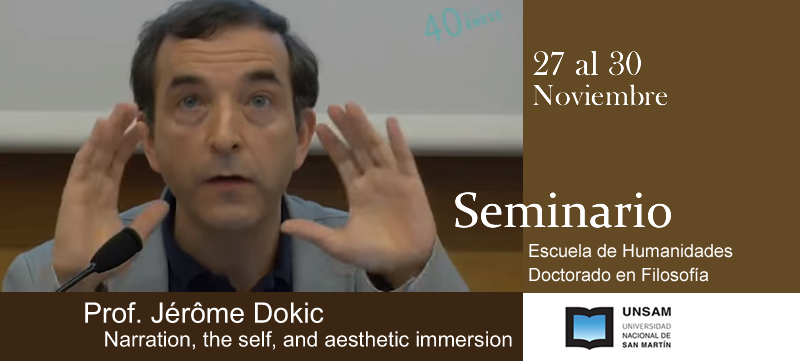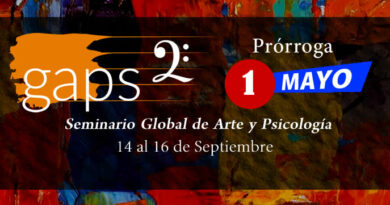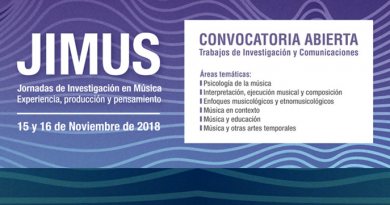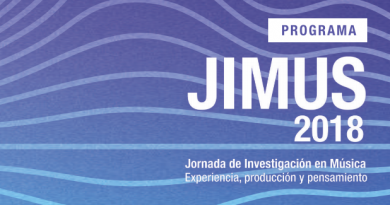Seminario del Prof. Jérôme Dokic
«Narration, the self, and aestehtic immersion», Seminario que Jérôme Dokic (Institut Jean Nicod,EHESS-PSL) impartirá en la sede del Doctorado en Filosofía de la Universidad Nacional de San Martín (Edificio Volta, Av. Pres. Roque Sáenz Peña 832/844, Piso4) del lunes 27 al jueves 30 de noviembre de noviembre.
La actividad cuenta con el auspicio del Programa de Estudios en Filosofía del Arte del Centro de Investigaciones Filosóficas (UA CONICET).
http://www.boletindeestetica.com.ar/…/narration-the-self-a…/
.———–.———————
Doctoral seminar
Narration, the self, and aesthetic immersion
Jérôme Dokic
(Institut Jean-Nicod, EHESS-PSL)
Syllabus
1) What is affective imagination?
The relationship between imagination and emotion is complex. Drawing from Peter Goldie’s account of imaginings as “mental narratives”, I suggest that affective imagination involves three distinct levels of epistemic and emotional perspectives, corresponding to the author (the imagining subject), the imagined character (if there is one) and what I call the “virtual narrator”, who paints the imaginary world in a specific emotional light. I show how the present account of affective imagination can be used to shed light on the vexed notion of affective memory, which points to an emotional way of representing one’s own past.
2) The sublime and the self
The sublime emerges in the history of philosophy as the object of an aesthetic experience contrasted with the aesthetic experience of the beautiful. In the light of recent psychological and neuroscientific studies, I suggest that the sublime gives rise to an aesthetic experience that, contrary to the experience of the beautiful, involves a diminished sense of the self. More precisely, sublimity experiences are immersive and blur the distinction between the self and the world. This claim has implications for a central question about the sublime, namely whether it is restricted to natural scenes or extends to artworks. I claim that in favourable conditions, art can elicit sublimity experiences.
3) Imaginative immersion I: pictures
What does it take to be imaginatively immersed in (static or dynamic) pictures? What is the relationship between imaginative immersion in pictures and Richard Wollheim’s notion of seeing-in? I draw on previous work about so-called “noetic feelings” and sketch an account of imaginative immersion in terms of a belief-independent feeling of reality or presence. I contrast this account with various enactivist attempts to explain our special relationship with pictures by means of the notion of sensorimotor contingencies.
4) Imaginative immersion II: virtual reality and other devices
In this lecture, I take on the notion of imaginative immersion developed in the previous lectures and apply it to immersive devices used for either therapeutic or artistic purposes. I start with an account of sensory substitution devices based on the dualism between sensory content and the feeling of presence. I then turn to other immersive devices used by artists to provoke a specific type of experience. A taxonomy of immersive devices will eventually be offered.
Literature
Brady, Emily, The Sublime in Modern Philosophy: Aesthetics, Ethics, and Nature, Cambridge: Cambridge University Press, 2013.
Currie, Gregory, Narrative and Narrators, Oxford: OUP, 2010.
Dokic J. (2016), “¿La experiencia estética como un sentimiento metacognitivo? Una visión de aspecto dual”, Boletín de Estética, 35 (2016): 35-65.
Goldie, Peter, The Mess Inside: Narrative, Emotion, and the Mind, Oxford: OUP, 2012
Saint Girons, Baldine, Le Sublime de l’antiquité à nos jours, Paris: Éditions Desjonquères, 2005.
Schaeffer, Jean-Marie, Pourquoi la fiction ?, París, Seuil, 1999.
Van Gerwen, Rob (ed.), Richard Wollheim on the Art of Painting: Art as Representation and Expression, Cambridge University Press, 2001
Wollheim, Richard, “What makes representational painting truly visual?”, Supplement to the Proceedings of the Aristotelian Society 77:1 (2003): 131-147.
_____, Painting as an Art, London: Thames and Hudson, 1987.
_____, Art and its Objects, Cambridge: Cambridge University Press, 2nd edn, 1980
_____, “Pictorial style: two views”, in Berel Lang (ed.), The Concept of Style, Philadelphia: University of Pennsylvania Press, 1979.
_____, On Art and the Mind, Cambridge, MA: Harvard University Press, 1973
Schedule
Monday 27 to Thursday 30 November, 2017
16-20 hs
Edificio Volta
Av. Pres. Roque Sáenz Peña 832/844
Seminar organized under the auspices of the Centro de Investigaciones Filosóficas (UA CONICET)





